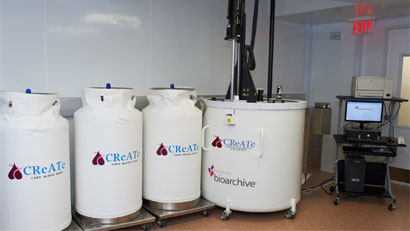
I woke up a few weeks ago to an email from Baby Centre telling me that I was 30 weeks pregnant. I could hardly believe it. While I’ve certainly been aware of my expanding belly—unlike my first pregnancy, I’ve been much less focused on tracking the weeks and milestones this time around.
But 30 weeks could not be ignored. My daughter was born at 38 weeks. That’s just 8 weeks from now. Or two months. Or 56 days.
I have a great big ‘to-do’ list to tackle before baby arrives, and this 30-week reality check was the incentive I needed to get started.
Book tour of Sunnybrook in preparation for delivering baby at a new hospital—check.
Schedule Hypnobirthing refresher course—check.
Finalize cord blood banking paperwork.
It was time to review the registration package I’d been given by CReATe, when I made the decision in early December to bank my baby’s cord blood with them.
In order to complete the paperwork, my husband and I each had to answer 50+ questions about our medical history—all meant to ensure that nothing that would contaminate the umbilical cord stem cells. (In follow-up to this questionnaire, I will have blood taken within seven days of baby’s birth to test for infectious diseases and other potential contaminates).
The next step was to decide which banking package we would select. CReATe, is unique to other Canadian banks, in that it offers parents the choice of banking just the cord blood or the cord blood and Peristem stem cells (scientifically referred to as mesenchymal stem cells or MSCs). These stem cells which are found around the blood vessels of the umbilical cord are the building blocks of the body’s structural tissues (bone, cartilage, muscle, and fibrous tissues) and could be used in the treatment of conditions such as degenerative arthritis, heart disease, traumatic injuries, burns, liver disease, MS, and more.
According to CReATe’s founder, Dr. Clifford Librach, more than 50 percent of families are now opting to bank both, recognizing great potential and future possibilities in the use of Peristem stem cells. The only barrier for some would be cost. The Peristem and cord blood package costs about $600 more up front, plus another $95/year in storage fees.

Now that our paperwork has been submitted, we wait for our collection kit to arrive in the mail. This kit must be kept at room temperature and must be brought with us to the hospital, as it includes everything the doctor or midwife needs to collect the umbilical cord blood and Peristem, plus some final paperwork for us to fill out at the time of delivery. Luckily, if you happen to forget the kit at home or are nowhere near home when you go into labour, most hospitals have emergency cord blood collection kits on hand.
When I wrote my first post about my journey through cord blood banking, I received many questions and comments, via social media and from friends, about cord blood banking and the logistics and ethics of deciding to bank or not bank baby’s blood. I decided to check in with Dr. Librach to see if he had answers to some of these questions and concerns.
Dr. Librach is the founder and director of the CReATe Fertility Centre, and has spent more than 20 years in the field of reproductive medicine. Because of the centre’s expertise in the area of cryobiology (or freezing things: namely embryos), it was a natural extension to move into cord blood banking, which required similar freezing technology. That, and, Dr. Librach was extremely interested in stem cell research and the ability of these cells to be used in the treatment and support of various diseases and conditions. He opened the CReATe Cord Blood Bank in 2005.
When it came to the preservation (or freezing) of stem cell samples, Dr. Librach said he was committed to finding and utilizing only the most advanced technology—in order to ensure the best possible results for his clients. On a previous visit to CReATe I was granted an insiders’ look at their state-of-the-art robotic Bioarchive system which is currently used only by the top banks in the world (namely The New York Blood Center, the Carolinas Cord Blood Bank at Duke and soon, Canadian Blood Services One Match Cord Blood Bank).
“I knew that this technology was going to be more expensive, the reason why most banks in Canada aren't using it, but I didn’t want to sacrifice quality for profit,” Dr. Librach tells me. “I’m a perfectionist, and I knew if I was going to do this, I’d have to do it right.”
What’s really cool (don’t mind the pun) about this freezing technology is that it’s equipped with a robotic arm that allows only one sample to be put into or removed from the tank at a time. This means no other samples are disturbed or exposed to what Dr. Librach calls a ‘transient warming event.’

While all of this seems a bit technical, considering I'm totally suffering from a case of 'pregnancy brain' right now...I do think it's good to really know what you’re investing in, especially when it comes to the future health of your family.
But, I digress. Here are a list of questions I posed to Dr. Librach–and the answers he provided.
Q: Is all the hype about cord blood banking legitimate or is it simply a way of playing on parents’ fears at a time when they’re especially vulnerable?
A: When you start to research cord blood banking online, you’ll begin to see all the uses for these stem cells that are being uncovered. To me, that’s extremely exciting. Of course, we all hope and pray that our children will never need to use the stored stem cells, but many parents think of it as biological insurance—an investment in your family's future wellbeing. We know it’s not for everyone, but our goal is to educate parents so that they’re able to make informed decisions—based on knowledge, not fear. What I think really excites people now is seeing that cord blood stem cells are being used to treat adults, not just children, and that new forms of treatment are being uncovered consistently.
(A few examples of how cord blood stem cells are being used in clinical trials can be found on the CReATe Facebook page. At the end of December, the Shanghai Daily reported that a five-year-old Chinese boy with a serious blood disease would receive a cord blood transplant—setting a record of 200 stem cell transplants in the city of Shanghai in 2012. Another post showed how cord blood stem cells are currently being tested in the United States as a potential treatment for the symptoms of cerebral palsy. Yet another post detailed the world’s first study (out of Sydney, Australia) to try to prevent the onset of type 1 diabetes by treating children with their own umbilical cord blood.)
Q: Is it necessary to bank for both (or all) of your children, or is banking for one child all that’s actually required?
A: This really depends on what the cells are being used to treat. There are some diseases where it’s going to be more effective to receive a transplant of your own cells, while there are others where the cells of a sibling (as long as he/she is a match) will be far more effective. If you were treating Cerebral Palsy, for example, you’d want your own cells; but, if you were treating Leukemia you might want the cells of a sibling. That’s why we recommend parents harvest and bank each of their children's cord blood.
Q: Does cord blood have a shelf life? I’ve heard it can only last 18 years.
A: No, it can be stored indefinitely as long as it’s kept in the tank. The current estimate is that it remains effective for 10,000 years.
Q: What about public banking? Once that becomes available in Canada why would you pay to bank your baby’s cord blood?
A: At CReATe we call ourselves a Family Bank. We believe it’s completely up to the parents as to whether they want to buy insurance for their family specifically (by banking with us), or donate their cord blood for public use. We think there is value in both options. There will always be those who are happy to donate their baby's cord blood (assuming the hospital they deliver at has the infrastructure in place to do so), and others who make the choice to invest in the protection of their own family.
CReATe Cord Blood Bank is funding this journey for me and my family; all opinions are my own.

This post is sponsored by our friends at CReATe Cord Blood Bank
www.createcordbank.com